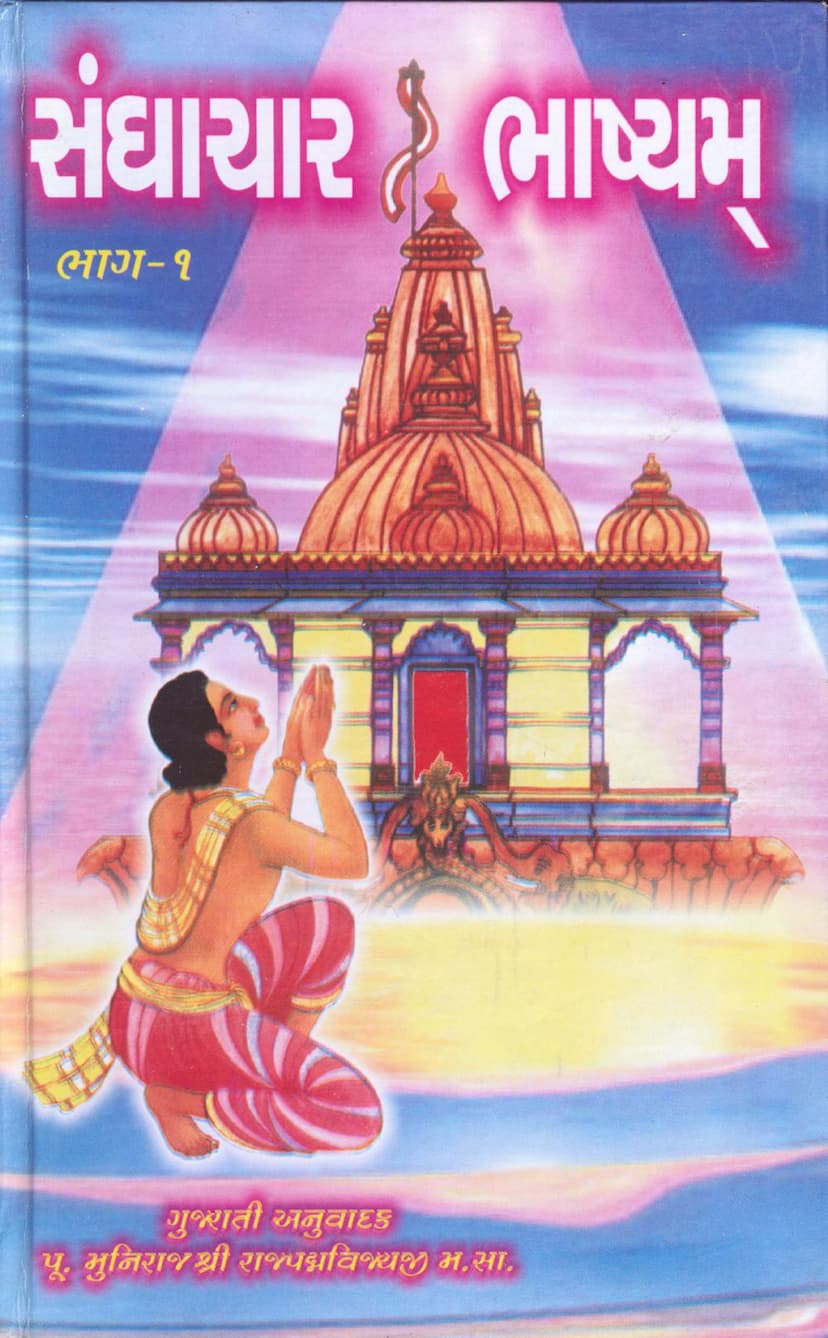Sanghachar Bhashyam Part 01
Added to library: September 2, 2025

Summary
Here's a comprehensive summary of the Jain text "Sanghachar Bhashyam Part 01," based on the provided pages:
Overall Purpose and Context:
"Sanghachar Bhashyam Part 01" is the Gujarati translation of a significant Jain text. The original work, "Chaityavandan Bhashya," was authored by Acharya Devendra Suri. The commentary and detailed explanation, known as "Sanghachar Bhashya," was then written by his disciple, Acharya Shri Dharmaghosha Suri. This translation aims to make this profound work accessible to the Gujarati-speaking Jain community, particularly to understand the intricate rituals and practices related to "Chaityavandan" (veneration of idols or sacred symbols in Jainism).
Author and Publisher Information:
- Original Work: "Chaityavandan Bhashya" by Acharya Devendra Suri.
- Commentary (Bhashya): "Sanghachar Bhashya" by Acharya Shri Dharmaghosha Suri.
- Gujarati Translator: Muni Shri Rajpadmavijayji Maharaj Saheb, a disciple of Acharya Vijay Rajendrasurishwarji Maharaj Saheb.
- Publisher: Shrutgyan Sanskar Peeth, Ahmedabad.
- Sponsorship: The publication is supported by Shri Vav Jain Sangh, Vav (Banaskantha) and family of Shrimati Ramilaben Sevantilal Sanghavi, Juna Dissa.
Key Content and Themes:
The text delves into the meticulous details of Jain practices, primarily focusing on "Chaityavandan." It aims to clarify the correct procedures, the philosophical underpinnings, and the significance of these rituals.
-
Author and Guru Parampara: The introductory sections highlight the lineage of the authors and gurus, emphasizing the scholarly tradition within the Tapa Gachha (a prominent monastic order in Jainism). Acharya Devendra Suri is noted for his wisdom, equanimity, and impactful teachings, while Acharya Dharmaghosha Suri is praised for his extensive commentary, drawing from various scriptures. The text also mentions the significant contributions and guidance received from other respected monks like Muni Chandravijayji, Muni Rajshekharvijayji, Muni Dhurandharvijayji, and others.
-
The Importance of Sanghachar (Conduct of the Community): The text underscores the importance of adhering to established codes of conduct within the Jain community, particularly concerning religious practices. "Sanghachar" refers to the collective conduct and practices of the Jain community.
-
Detailed Explanation of Chaityavandan: The core of the text is dedicated to explaining "Chaityavandan." This includes:
- Mangala (Auspicious Beginnings): The importance of starting any religious or scholarly endeavor with auspicious invocations and praises to the divine beings (Arihants, Siddhas, Gurus).
- The Concept of 'Vandana' (Veneration): Explaining the different ways of veneration, including mental, verbal, and physical acts, and emphasizing the importance of "bhava vandana" (mental veneration) over mere ritualistic actions.
- The Four Atishayas (Special Attributes of Tirthankaras): The text elaborates on the divine attributes of Tirthankaras (omniscience, impeccability, miraculous speech, and divine radiance) as displayed in their images and presence, which are to be contemplated during veneration.
- The Twenty-Four Doors (Dwaras) and Their Significance: The text details 24 primary categories or "doors" of Chaityavandan, which encompass various aspects of veneration, purification, meditation, and conduct. Each of these doors has further subdivisions, leading to a total of 2074 specific points of practice within Chaityavandan.
- The Role of Rituals and Practices: The text emphasizes the correct performance of rituals, including proper posture, pronunciation of mantras, and the significance of specific actions like bowing, circumambulating, and offering.
- Stories and Examples: To illustrate the teachings, the text incorporates various narratives and examples from Jain scriptures and traditions, such as the stories of Raja Vijaya, Mrigavati, Bhuvanmalla, Dharmaruchi, Nanda-Vinami, Devadatta, Sumati, and others. These stories serve to explain the principles and the consequences of following or deviating from the prescribed conduct.
- Addressing Different Schools of Thought (Mata-antar): The commentary addresses and refutes differing interpretations or practices found in other Jain traditions (e.g., Kharatargachhiya, Anchalgachhiya) by providing scriptural evidence and logical reasoning.
- The Meaning of 'Chaitya': The text clarifies the meaning of 'Chaitya' as a place of worship or an object of worship, often referring to the idols of Tirthankaras, and explains why the veneration of these is called 'Chaityavandan.'
- Purity and Intent: Emphasis is placed on the purity of intent and action during religious observances. The text discusses the importance of maintaining a pure mind and avoiding distractions.
- The Three Types of Pooja (Worship): Anga Pooja (worship of the body parts of the idol), Agra Pooja (offering of items before the idol), and Bhava Pooja (mental worship). It also touches upon Panchopachari, Ashtopachari, and Sarvopachari pooja.
- The Concept of 'Pranidhan' (Concentration/Meditation): The text explains the importance of focusing the mind, speech, and body during rituals, and the three types of Pranidhan: Chaityavandan, Munivandan, and Prayer.
- The Importance of Abhigama (Approach/Entry Rules): The text outlines specific rules for entering the temple, emphasizing respect and purity.
- The Significance of Different Pillars of Jainism: The text highlights the roles and importance of Arihants, Siddhas, Acharyas, Upadhyayas, and Sadhus (the five Parmeshthis) as objects of veneration.
- Moksha (Liberation) as the Ultimate Goal: While detailing the practices, the underlying purpose is to guide individuals towards spiritual purification and ultimately, liberation from the cycle of birth and death.
-
The Role of 'Shrutgyan Sanskar Peeth': The publisher, Shrutgyan Sanskar Peeth, is presented as an institution dedicated to preserving and disseminating Jain knowledge. It actively encourages participation and support through various membership schemes to facilitate the publication of more such valuable religious texts.
Overall Message:
The "Sanghachar Bhashyam Part 01" (Gujarati Translation) serves as a guide for Jain followers to understand and correctly perform rituals, particularly Chaityavandan. It emphasizes the spiritual and ethical dimensions of these practices, encouraging devotion, purity of intent, and adherence to the teachings of the Jain Tirthankaras and their disciples. The translation makes this intricate knowledge accessible, fostering a deeper connection with Jain traditions and practices for a wider audience.